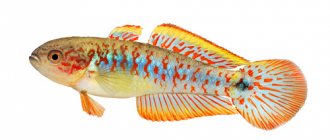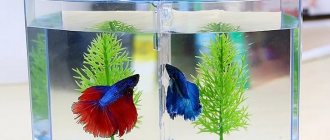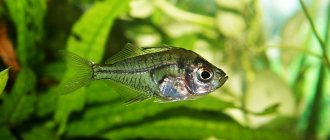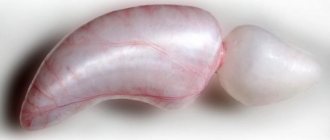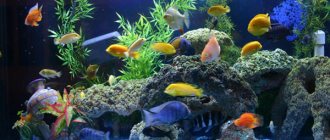The bee goby (lat. Brachygobius Xanthozona) is a small, bright and peaceful fish that owners of small aquariums are happy to buy. However, you can often find another goby on sale - brachygobius doriae, and it is very difficult to distinguish one species from another.
Although these fish are different, they are so similar in appearance that even ichthyologists have not yet determined exactly which one is which.
For ordinary aquarium fish lovers, such things are of little interest, and from now on we will simply call it the bee goby or brachygobius.
Habitat in nature
It lives in Malaysia, on the island of Borneo, being endemic to the eastern part of the island.
It is also found on the islands of the Natuno archipelago, which lies off the west coast of Borneo and belongs to Indonesia.
Found in both fresh and brackish water, it is primarily found in low-lying, coastal areas including mangroves, intertidal zones and estuaries.
The substrate in such areas consists of silt, sand and mud, with the inclusion of organic materials such as fallen leaves, mangrove roots and various driftwood.
Part of the population lives in peat bogs, with tea-colored water, very low acidity and very soft water.
Goby bee
Goby bee brachygobius
Synonyms: goby baby, goby bumblebee, goby beeline.
Family: Gobies (Gobiidae).
Habitat: South Asia (India, Thailand, Indonesia, Borneo, Malaysia).
Water temperature: 24-28.
Size in aquarium: 3-4 cm
Recommended aquarium volume for keeping: from 20 liters per individual.
Brachygobius - bee gobies (Brachygobius nunus, Brachygobius anthozona, brachygobius doriae) are closely related gobies that got their name because of their round body shape, large head and body color.
Goby bee brachygobius
The biotope of bee gobies is the backwaters of mangrove forests: silt, sand, fallen leaves, branches.
Description of the bee goby - the body is compressed at the back, cylindrical at the front. The upper jaw is shorter than the lower jaw. The body is yellowish-brown in color with stripes running from the eyes to the tail. The dorsal and adipose fins are black in color, while the other fins are mostly translucent. The pelvic fins of the goby are fused, thereby forming a kind of suction cup, with the help of which the gobies can attach to any surface and at any angle. The anal fin of the bee goby has 7 rays.
Goby bees prefer to eat live food: shrimp, brine shrimp, bloodworms, and daphnia. But it can also be tamed to dry food. Feeding aquarium fish should be correct: balanced, varied. This fundamental rule is the key to the successful keeping of any fish, be it guppies or astronotuses. The article “How and how much to feed aquarium fish” talks about this in detail; it outlines the basic principles of the diet and feeding regime of the fish.
In this article, we note the most important thing - feeding fish should not be monotonous; the diet should include both dry food and live food. In addition, you need to take into account the gastronomic preferences of a particular fish and, depending on this, include in its diet food either with the highest protein content or, conversely, with plant ingredients.
Popular and popular food for fish, of course, is dry food. For example, you can constantly and everywhere find food from Tetra, the leader of the Russian market, on aquarium shelves; in fact, the range of food from this Tetra is included as individual food for a specific type of fish: for goldfish, for cichlids, for loricariids, guppies, labyrinths, arowanas, and discus fish. etc. Tetra has also developed specialized foods, for example, to enhance color, fortified, or for feeding fry. You can find out detailed information about all Tetra feeds on the company’s official website - here .
It should be noted that when purchasing any dry food, you should pay attention to the date of its manufacture and shelf life, try not to buy food in bulk, and also store the food in a closed state - this will help to avoid the development of pathogenic flora in it.
Keeping gobies bees . These fish love hard alkaline water; if the water in your aquarium is soft, you can increase the hardness with boosters; it is also recommended to add salt to the water at the rate of 2 grams of sea salt per 1 liter. aquarium water. Gobies do not like strong currents, so shelters are needed. Filtration, aeration, absence of nitrogenous compounds, weekly water changes are mandatory.
It is important to remember that the bee goby is a fish that lives in brackish water, which is sometimes introduced into a freshwater aquarium. Some aquarists are quite successful in keeping them in fresh water, but the ideal conditions would still be brackish water. Although gobies can be called peaceful fish, they are still very territorial and should be kept in aquariums with plenty of hiding places. Neighbors may be the same alkaline and salt-water-loving fish.
Keeping in an aquarium
It is important to remember that the bee goby is a brackish water fish that is sometimes introduced into a freshwater aquarium. Some aquarists quite successfully keep them in fresh water, but the ideal conditions will still be brackish water.
Although they can be called peaceful fish, they are still very territorial and should be kept in aquariums with plenty of hiding places.
In the aquarium you need to create a large number of different shelters, the main thing is that the fish do not have direct visibility, and weaker individuals can hide from dominant ones.
Pots, driftwood, large stones, ceramic and plastic tubes, and coconuts are suitable. The volume of the aquarium is not as important for them as the bottom area, so that each fish has its own territory.
Minimum area 45 by 30 cm.
Since bee gobies prefer brackish water, it is recommended to add sea salt at the rate of 2 grams per liter.
As already mentioned, they also live in fresh water, but their lifespan in this case is reduced.
Parameters for maintenance: temperature 22 – 28°C, pH: 7.0 – 8.5, hardness – 143 – 357 ppm.
Description
Example of Bee Goby from Sarawak Province.
It has a more intense color than the normal yellow Brachygobius Doriae. The bumblebee goby has a body shape characteristic of representatives of its genus in the form of an elongated drop flattened on the sides. The head is large in comparison with the body. The fused pelvic fins form a kind of suction cup, with the help of which the fish attaches to surfaces. The two dorsal fins have anterior and posterior soft rays.
When favorable conditions are created, the fish have a very bright and contrasting color of alternating golden-yellow and velvety-black stripes, giving them a resemblance to bees/bumblebees, which was the basis for the name. Some individuals have a blurry dark spot on the back.
Females are larger and plumper; before spawning, their abdominal line is noticeably rounded. Males are more elegant and have a bright color: their stripes may not be yellow, but orange or reddish.
Bee/Bumblebee goby (Brachygobius) - male and female.
Under natural conditions it grows up to 4.2 cm, the maximum size in an aquarium is 25 - 35 mm.
Compatibility
Bee gobies are not suitable for community aquariums, as they need brackish water and are territorial, plus they can seriously chase fish living in the bottom layer.
It is ideal to keep them separately. And here is another paradox: although they are territorial, you need to keep at least 6 of them per aquarium.
The fact is that with such an amount, aggression is distributed evenly, and the fish also become brighter and demonstrate more natural behavior.
Small predators eat shrimp with pleasure, so it is better not to keep them with cherries and other small shrimp.
Breeding
Breeding process of Goby Bee/Bumblebee
will be of interest not only to beginners, but also to experienced aquarists.
This species spawns in small shelter caves in the form of small flower pots, ceramic pipes, shells, and the like.
Spawning is possible both in a separate spawning tank and in a species aquarium.
If the fish live in a group, then it is better to let them choose their own mate. During the pre-spawning period, they need to be fed intensively and variedly, and the process is stimulated by replacing part of the water, raising the temperature by several degrees and increased aeration.
First, the male chooses a cave or other shelter, carefully driving away rivals from him and at the same time trying to lure the female there.
If his efforts are crowned with success, she spawns 100-200 whitish drop-shaped eggs with a diameter of 1 mm, and then immediately leaves, since the female will not show any interest in her offspring. The male, on the contrary, after fertilization of the eggs becomes a “caring dad” and protects it for 3-5 days until the larvae appear, but then he too becomes dangerous, or rather simply not needed, since he has completed his mission and therefore leaves.
The incubation period is 7-9 days.
Free swimming of the fry begins after a couple of days.
The fry are 16 days old and at this size they no longer require starter feed.
Starter food: live dust - ciliates and rotifers. Even short-term starvation can lead to mass death of offspring. Grown-up fry can accept crushed tubifex and Artemia nauplii.
Baby Bee Goby (Brachygobius doriae), one and two months old, respectively.
The juveniles grow very slowly and reach a centimeter in length only by the age of one month with good nutrition. At 2 months, the fish begin to display behavior and coloration characteristic of adults.
Reaches sexual maturity at 8-12 months.
In an aquarium, the Bee/Bumblebee Goby (Brachygobius doriae) can live 4-5 years.
Maintenance and care
Conditions
The small size of the fish allows you to select small tanks from 5-10 liters for its existence. However, the rasbora brigitta is a gregarious creature; in addition, against the background of an aquarium, single individuals will simply get lost, so it is recommended to purchase this species in quantities of 10 or more individuals. Nimble and agile, they will become a magnificent decoration of the aquarium. For a flock, an aquarium will require from 30 liters.
Water for fish must meet the following standards: hardness – up to 15°dH (ideally up to 7), acidity – 5.5-7pH, temperature – 22-26°C. Water changes are carried out once a week, approximately a third of the volume is replaced.
A compressor or filter with a water aeration function is required.
It is also important to have waterfowl plants in which the rasboras can hide, and various types of moss will also add comfort. The lighting is dim, or bright and shaded areas should alternate
The choice of soils and decorations is yours.
Feeding
Rasboras are unpretentious in nutrition; they eat any type of food. The main thing is that the food is of the appropriate size (the fish simply cannot swallow pieces that are too large). They will happily eat crushed bloodworms and will also benefit from Artemia nauplii. To enhance color, it is advisable to alternate dry and live food.
Compatibility with other fish
Rasbora bridget is one of the most peaceful fish; its neighbors can be all sorts of small species (quite peaceful) or larger fish. There are reports that rasboras are able to coexist with cichlids, but the aquarium must be very spacious. In addition, rasbora is one of the few aquarium fish that can get along with aquarium shrimp without showing any aggression towards the latter.
Rasbora brigitta reproduction and breeding
Rasbora brigitta photo
Rasbora brigittas reach sexual maturity at the age of 10 months, after which females spawn continuously, laying eggs in small portions almost every day. If the aquarium has thickets of plants and mosses, and the water parameters are satisfactory for fish, then fry will appear in it without your intervention. Newly hatched fry feed on the yolk sac located near them. Usually it lasts for a day, after which the fry begin to be fed with small cyclops and rotifers. After about two weeks, the fry can be given brine shrimp or brine shrimp.
All of the above is just the fruit of observing this type of aquarium fish and collecting various information from owners and breeders. We would like to share with visitors not only information, but also live emotions that allow us to understand the world of aquariums more fully and subtly. Register at https://fanfishka.ru/forum/, participate in discussions on the forum, create profile topics where you will talk about your pets in the first person and from the horse’s mouth, describe their habits, behavior and content, and share with us your successes and joys, share your experiences and learn from the experiences of others. We are interested in every bit of your experience, every second of your joy, every awareness of a mistake, which makes it possible for your comrades to avoid the same mistake. The more of us there are, the more pure and transparent drops of goodness there are in the life and everyday life of our seven billion society.
Rasbora Brigitta video review
What kind of fish is this?
Rasbora brigitta or Boraras brigitta is a small fish measuring from 1.3 to 2.2 cm. In Latin the name is Boraras brigittae, belongs to the family Cyprinidae. The fish was named in honor of the wife of the researcher who discovered and described this species. This fish is the tiniest among the entire cyprinid family.
It lives in the southwestern part of the island of Borneo in Indonesia in black waters, streams and rivers. The water is called black because of the branches and leaves that rot in it. It receives a small amount of daylight due to the dense tree canopies. The advantages of such an environment include the softness and high acidity of the water.
Character
This fish is quite peaceful and goes well with other relatives that are suitable in size. They do not show aggression towards other individuals.
Brightly colored mosquitoes have a unique temperament. Adults almost always swim on top of the aquarium.
Description of appearance
The female differs from the male in the color of her fins:
- in females they are orange or pink;
- In males, the fin is red with a pronounced black edge.
In addition, females differ from males in their larger size. But the males are brightly colored. Upon reaching one year of age, the dominant male in the flock acquires a bright color, unlike his relatives.
Brigitta differs from its rasbora relatives by only 2.2 cm in length, while other species reach sizes of up to 6 cm or more. Also a distinctive feature of this species is the presence of a dark stripe and border on the fins.
Next in the video you can see the appearance of Brigitte's combing:
How long does it live and what affects these indicators?
The lifespan of fish depends on their living conditions. On average it varies from 2 to 4 years. In order for aquatic inhabitants to live long and delight their owners with beautiful colors and activity, they must be fed properly and the condition of the water monitored. and choose your neighbors carefully.
In the following photo you can see Brigitte’s rasbora:
Brachygobius or bee goby
The bee goby (lat. Brachygobius anthozona, also Brachygobius bee, beeline goby, bumblebee goby, Brachygobius baby) is a small, bright and peaceful fish that owners of small aquariums are happy to buy.
However, you can often find another goby on sale - brachygobius doriae, and it is very difficult to distinguish one species from another.
Although these fish are different, they are so similar in appearance that even ichthyologists have not yet determined exactly which one is which.
For ordinary aquarium fish lovers, such things are of little interest, and from now on we will simply call it the bee goby or brachygobius.
Brachygobius nunus (Brachygobius nunus)
Brachygobius nunus (Brachygobius nunus)
Post by Nyusha » June 25, 2012, 21:54
General information on Brachygobius nunus (Brachygobius nunus):
Family: Gobies (Gobiidae) Origin: South Asia (India, Thailand, Indonesia, Borneo, Malaysia) Water temperature: 24-30 Acidity: 7.5-8.5 Hardness: 10-24 Maximum size in the aquarium: 3-4 cm Habitat layers: Lower level Minimum recommended aquarium volume for 1 adult: from 20 liters
Additional information on Brachygobius nunus (Brachygobius nunus): Bumblebee gobies got their name due to the round shape of the body, large head and coloring - brown-black stripes on a yellow background. Bumblebee gobies live in estuaries and mangrove forests. The body is bumblebee gobies are compressed at the back, cylindrical at the front and small in size. The upper jaw is shorter than the lower jaw. The body is yellowish-brown in color with 4 stripes running from the eyes to the tail. The dorsal and adipose fins are black in color, the other fins are mostly translucent. The pelvic fins are goby are fused, thereby forming a kind of suction cup, with the help of which gobies can attach to any surface and at any angle. The anal fin of Brachygobius nunus has 7 rays. Males from females can only be distinguished during the spawning period; in males, the dark stripes on the body turn pale and he becomes almost all yellow. He prefers to eat live food: small shrimp, brine shrimp, bloodworms, daphnia. It is better to add 2 teaspoons of sea salt per 1 liter of water to the water in the aquarium, increasing salinity, they do not like strong currents, decorate the aquarium with stones and caves. To stimulate spawning, you need to increase nutrition, also increase salinity and make frequent large water changes. For breeding you need a small 10 liter aquarium; spawning will not happen in a large one. The male invites the female to the spawning area and she lays eggs there, up to 100-150 eggs. The male guards the nest until the fry hatch. The fry need to be separated from their parents in a separate aquarium. After about 2 months, the fry will turn into a smaller copy of their parents. Life expectancy is 5-8 years.
